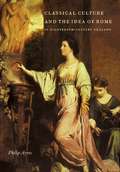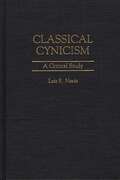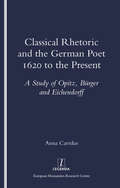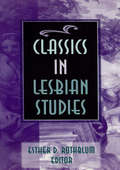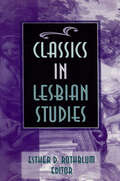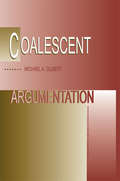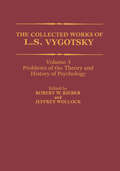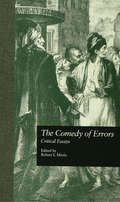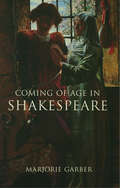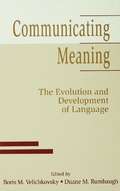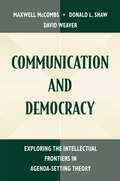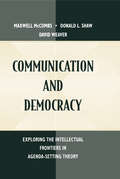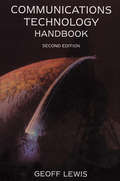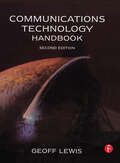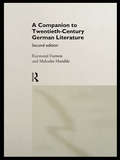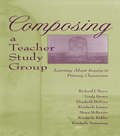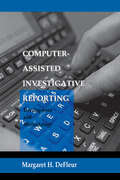- Table View
- List View
Classical Culture and the Idea of Rome in Eighteenth-Century England (PDF)
by Philip AyresThis book is the first to look at the aristocratic adoption of Roman ideals in eighteenth-century English culture and thought. Philip Ayres shows how, in the century following the Revolution of 1688, the ruling class promoted-by way of its patronage-a classical frame of mind embracing all the arts, on the foundations of 'liberty' and 'civic virtue'. The historical fact of a Roman Britain lent the endeavour an added authenticity, and it was partly out of an attachment to that past that a new 'Roman' present was constructed by Lord Burlington and his circle. Ayres's study shows that the propensity to adopt the self-image of virtuous Romans was the attempt of a newly empowered oligarchy to dignify and vindicate itself by association with an idealised image of republican Rome. This sense of affinity with the ideals of the free Roman Republic gave British classicism an authenticity impossible under the various versions of absolutism on the continent. Its discourse precluded any more thorough-going revolution by suggesting that Britain's liberty had been won by an 'oligarchy of virtue' which now defended, defined and emblematised the nation.
Classical Cynicism: A Critical Study (Contributions in Philosophy)
by Luis NaviaMore than a school of philosophy with a defined set of beliefs and convictions, classical Cynicism represents an unconventional sect of philosophers and a way of life. This is a complete account of classical Cynicism from its beginnings in the Socratic circle to its extinction in late Roman times. In this thoroughly documented study, Navia explores various issues related to the sources of information about the Cynics, the development of Cynicism, and the principal representatives of classical Cynicism. Exploring the relationship between classical Cynicism and cynicism as understood in its ordinary modern sense, the author argues that despite their common designation, they represent significantly different philosophical attitudes. This book explicates the main ideas associated with classical Cynicism and argues that, its shortcomings notwithstanding, classical Cynicism furnishes us with a wealthy source of philosophical enlightenment.Individual chapters are devoted to Antisthenes, Diogenes, and Crates, the three principal classical Cynics. Attention is given to the development and application of certain fundamental Cynic ideas and to the transformation of these ideas throughout the eight centuries during which Cynicism was an influential philosophical movement. The book provides abundant references to primary and secondary sources and includes a bibliography of over five hundred entries.
Classical Rhetoric and the German Poet: 1620 to the Present - Study of Opitz, Burger and Eichendorff
by Anna Carrdus"This study relates theory to the details of poetic practice. it presents Opitz, Burger and Aichendorff as representatives of their times and demonstrates how they adapt the classical arts to their particular talents and beliefs. All three poets are shown at work within a tradition flexible enough to persist even into the present. The author shows how the influence of rhetoric on German poetry did not vanish in the mid-18th century, as is widely supposed. The firts chapter briefly comapres theoretical statements by martin Opitz and the 20th century poet peter Ruhmkorf. it uses the comaprison to introduce two main arguments: thta classical rhetoric and poetics exert a persistent though constantly changing influence on the composition of german poetry; and that the theoretical precepts and natural talent are mutually interdependant. These arguments are developed through the examination of works by three German poets, taken from periods of major literary change. Opitz is representative of the Baroque, Burger of the ""Sturm and Drang"", and eichendorff of Romanticism. Three main chapters reconstruct the working method of each poet, applying his own theory and that of near contemporaries to detailed analysis of one of two of his poems. This procedure illustrates how each poet adapts rhetorical and poetic traditions to his own personal talent and to the literary preoccupations of his time."
Classical Rhetoric and the German Poet: 1620 to the Present - Study of Opitz, Burger and Eichendorff
by Anna Carrdus"This study relates theory to the details of poetic practice. it presents Opitz, Burger and Aichendorff as representatives of their times and demonstrates how they adapt the classical arts to their particular talents and beliefs. All three poets are shown at work within a tradition flexible enough to persist even into the present. The author shows how the influence of rhetoric on German poetry did not vanish in the mid-18th century, as is widely supposed. The firts chapter briefly comapres theoretical statements by martin Opitz and the 20th century poet peter Ruhmkorf. it uses the comaprison to introduce two main arguments: thta classical rhetoric and poetics exert a persistent though constantly changing influence on the composition of german poetry; and that the theoretical precepts and natural talent are mutually interdependant. These arguments are developed through the examination of works by three German poets, taken from periods of major literary change. Opitz is representative of the Baroque, Burger of the ""Sturm and Drang"", and eichendorff of Romanticism. Three main chapters reconstruct the working method of each poet, applying his own theory and that of near contemporaries to detailed analysis of one of two of his poems. This procedure illustrates how each poet adapts rhetorical and poetic traditions to his own personal talent and to the literary preoccupations of his time."
Classics in Lesbian Studies
by Esther D RothblumClassics in Lesbian Studies takes a major step in giving the lesbian experience its own unique voice within scholarship and the larger world society. Thus, it is devoted exclusively to the lesbian experience and serves as a vehicle for the promotion of scholarship and commentary on lesbianism from an international perspective. Not only does it ensure that “classic” pieces are not forgotten by new generations of students and scholars, it also spurs further lesbian research, writing, theory, and scholarship.In Classics in Lesbian Studies, you are introduced to descriptive, theoretical, empirical, applied, and multicultural perspectives in the field of lesbian studies. Interdisciplinary, the book presents pieces from various academic areas in multiple formats, including personal accounts, poetry, editorials, debates, and commentaries. For your convenience, the chapters are organized primarily across four categories: identity, history and literature, physical and social sciences, and “back to lesbian politics.” You will find the discussions of the following issues and subjects provocative and insightful: ways black women in the diaspora construct and name their sexual and romantic feelings for other women lesbian identity formation in a changing social environment how lesbians maneuver in the dominant culture and their own subculture lesbianism as a political movement the experiences of lesbian adolescents teaching lesbian studies lesbians and societal institutions, including the work place, the media, the political arena, the legal system, and religion using lesbian-feminist scholarship to reexamine women's lives in the pastStudents, scholars, lesbian feminists, and others interested in lesbian studies will find Classics in Lesbian Studies a vital examination of lesbianism since its grass roots. Not only does it consider the progress made since the initial days of fighting for liberation, it also explores a more distant, repressed past and anticipates future possibilities lying before us. This powerful, insightful collection is sure to become a classic as it grapples with virtually all aspects of lesbianism, from its inception as a political movement to its identity as a lifestyle choice to its implications of community.
Classics in Lesbian Studies
by Esther D RothblumClassics in Lesbian Studies takes a major step in giving the lesbian experience its own unique voice within scholarship and the larger world society. Thus, it is devoted exclusively to the lesbian experience and serves as a vehicle for the promotion of scholarship and commentary on lesbianism from an international perspective. Not only does it ensure that “classic” pieces are not forgotten by new generations of students and scholars, it also spurs further lesbian research, writing, theory, and scholarship.In Classics in Lesbian Studies, you are introduced to descriptive, theoretical, empirical, applied, and multicultural perspectives in the field of lesbian studies. Interdisciplinary, the book presents pieces from various academic areas in multiple formats, including personal accounts, poetry, editorials, debates, and commentaries. For your convenience, the chapters are organized primarily across four categories: identity, history and literature, physical and social sciences, and “back to lesbian politics.” You will find the discussions of the following issues and subjects provocative and insightful: ways black women in the diaspora construct and name their sexual and romantic feelings for other women lesbian identity formation in a changing social environment how lesbians maneuver in the dominant culture and their own subculture lesbianism as a political movement the experiences of lesbian adolescents teaching lesbian studies lesbians and societal institutions, including the work place, the media, the political arena, the legal system, and religion using lesbian-feminist scholarship to reexamine women's lives in the pastStudents, scholars, lesbian feminists, and others interested in lesbian studies will find Classics in Lesbian Studies a vital examination of lesbianism since its grass roots. Not only does it consider the progress made since the initial days of fighting for liberation, it also explores a more distant, repressed past and anticipates future possibilities lying before us. This powerful, insightful collection is sure to become a classic as it grapples with virtually all aspects of lesbianism, from its inception as a political movement to its identity as a lifestyle choice to its implications of community.
Coalescent Argumentation
by Michael A. GilbertCoalescent Argumentation is based on the concept that arguments can function from agreement, rather than disagreement. To prove this idea, Gilbert first discusses how several components--emotional, visceral (physical) and kisceral (intuitive) are utilized in an argumentative setting by people everyday. These components, also characterized as "modes," are vital to argumentative communication because they affect both the argument and the resulting outcome. In addition to the components/modes, this book also stresses the goals in argumentation as a means for understanding one's own and one's opposer's positions. Gilbert argues that by viewing positions as complex human events involving a variety of communicative modes, we are better able to find commonalities across positions, and, therefore, move from conflict to resolution. By focusing on agreement and shared goals in all modes, arguers can coalesce diverse positions and more easily distinguish between minor or unrelated differences and core disagreements. This permits much greater latitude for locating shared beliefs, values, and attitudes that will lead to conflict resolution.
Coalescent Argumentation
by Michael A. GilbertCoalescent Argumentation is based on the concept that arguments can function from agreement, rather than disagreement. To prove this idea, Gilbert first discusses how several components--emotional, visceral (physical) and kisceral (intuitive) are utilized in an argumentative setting by people everyday. These components, also characterized as "modes," are vital to argumentative communication because they affect both the argument and the resulting outcome. In addition to the components/modes, this book also stresses the goals in argumentation as a means for understanding one's own and one's opposer's positions. Gilbert argues that by viewing positions as complex human events involving a variety of communicative modes, we are better able to find commonalities across positions, and, therefore, move from conflict to resolution. By focusing on agreement and shared goals in all modes, arguers can coalesce diverse positions and more easily distinguish between minor or unrelated differences and core disagreements. This permits much greater latitude for locating shared beliefs, values, and attitudes that will lead to conflict resolution.
The Collected Works of L. S. Vygotsky: Problems of the Theory and History of Psychology (Cognition and Language: A Series in Psycholinguistics)
by L. S. VygotskyThe Comedy of Errors: Critical Essays (Shakespeare Criticism)
by Robert S. MiolaThis collection of essays and reviews represents the most significant and comprehensive writing on Shakespeare's A Comedy of Errors. Miola's edited work also features a comprehensive critical history, coupled with a full bibliography and photographs of major productions of the play from around the world. In the collection, there are five previously unpublished essays. The topics covered in these new essays are women in the play, the play's debt to contemporary theater, its critical and performance histories in Germany and Japan, the metrical variety of the play, and the distinctly modern perspective on the play as containing dark and disturbing elements. To compliment these new essays, the collection features significant scholarship and commentary on The Comedy of Errors that is published in obscure and difficulty accessible journals, newspapers, and other sources. This collection brings together these essays for the first time.
The Comedy of Errors: Critical Essays (Shakespeare Criticism)
by Robert S. MiolaThis collection of essays and reviews represents the most significant and comprehensive writing on Shakespeare's A Comedy of Errors. Miola's edited work also features a comprehensive critical history, coupled with a full bibliography and photographs of major productions of the play from around the world. In the collection, there are five previously unpublished essays. The topics covered in these new essays are women in the play, the play's debt to contemporary theater, its critical and performance histories in Germany and Japan, the metrical variety of the play, and the distinctly modern perspective on the play as containing dark and disturbing elements. To compliment these new essays, the collection features significant scholarship and commentary on The Comedy of Errors that is published in obscure and difficulty accessible journals, newspapers, and other sources. This collection brings together these essays for the first time.
Coming of Age in Shakespeare
by Marjorie GarberMarjorie Garber examines the rites of passage and maturation patterns--"coming of age"--in Shakespeare's plays. Citing examples from virtually the entire Shakespeare canon, she pays particular attention to the way his characters grow and change at points of personal crisis. Among the crises Garber discusses are: separation from parent or sibling in preparation for sexual love and the choice of husband or wife; the use of names and nicknames as a sign of individual exploits or status; virginity, sexual initiation and the acceptance of sexual maturity, childbearing and parenthood; and, finally, attitudes toward death and dying.
Coming of Age in Shakespeare
by Marjorie GarberMarjorie Garber examines the rites of passage and maturation patterns--"coming of age"--in Shakespeare's plays. Citing examples from virtually the entire Shakespeare canon, she pays particular attention to the way his characters grow and change at points of personal crisis. Among the crises Garber discusses are: separation from parent or sibling in preparation for sexual love and the choice of husband or wife; the use of names and nicknames as a sign of individual exploits or status; virginity, sexual initiation and the acceptance of sexual maturity, childbearing and parenthood; and, finally, attitudes toward death and dying.
Communicating Meaning: The Evolution and Development of Language
by Boris M. Velichkovsky Duane M. RumbaughDealing specifically with the origins and development of human language, this book is based on a selection of materials from a recent international conference held at the Center of Interdisciplinary Research at the University of Bielefeld in Germany. The significance of the volume is that it testifies to paradigmatic changes currently in progress. The changes are from the typical emphasis on the syntactic properties of language and cognition to an analysis of biological and cultural factors which make these formal properties possible. The chapters provide in-depth coverage of such topics as new theoretical foundations for cognitive research, phylogenetic prerequisites and ontogenesis of language, and environmental and cultural forces of development. Some of the arguments and lines of research are relatively well-known; others deal with completely new interdisciplinary approaches. As a result, some of the authors' conclusions are in part, rather counterintuitive, such as the hypothesis that language as a system of formal symbolic transformations may be in fact a very late phenomenon located in the sphere of socio-cultural and not biological development. While highly debatable, this and other hypotheses of the book may well define research questions for the future.
Communicating Meaning: The Evolution and Development of Language
by Boris M. Velichkovsky Duane M. RumbaughDealing specifically with the origins and development of human language, this book is based on a selection of materials from a recent international conference held at the Center of Interdisciplinary Research at the University of Bielefeld in Germany. The significance of the volume is that it testifies to paradigmatic changes currently in progress. The changes are from the typical emphasis on the syntactic properties of language and cognition to an analysis of biological and cultural factors which make these formal properties possible. The chapters provide in-depth coverage of such topics as new theoretical foundations for cognitive research, phylogenetic prerequisites and ontogenesis of language, and environmental and cultural forces of development. Some of the arguments and lines of research are relatively well-known; others deal with completely new interdisciplinary approaches. As a result, some of the authors' conclusions are in part, rather counterintuitive, such as the hypothesis that language as a system of formal symbolic transformations may be in fact a very late phenomenon located in the sphere of socio-cultural and not biological development. While highly debatable, this and other hypotheses of the book may well define research questions for the future.
Communication and Democracy: Exploring the intellectual Frontiers in Agenda-setting theory (Routledge Communication Series)
by Maxwell E. McCombs Donald L. Shaw David H. WeaverExciting intellectual frontiers are open for exploration as agenda-setting theory moves beyond its 25th anniversary. This volume offers an intriguing set of maps to guide this exploration over the near future. It is intended for those who are already reasonably well read in the research literature that has accumulated since the publication of McCombs and Shaw's original 1972 Public Opinion Quarterly article. This piece of literature documented the influence of the news media agenda on the public agenda in a wide variety of geographic and social settings, elaborated the characteristics of audiences and media that enhance or diminish those agenda-setting effects, and cataloged those exogenous factors explaining who sets the media's agenda. In the current volume, a provocative set of maps for explicating new levels of agenda-setting theory have been sketched by a new generation of young scholars, launching an enterprise that has significant implications for theoretical research and for the day-to-day role of mass communication in democratic societies. At the first level of agenda setting are agendas of objects--the traditional domain of agenda setting research--represented by an accumulation of hundreds of studies over the past quarter century. At the second level of agenda setting are agendas of attributes--one of the new theoretical frontiers whose aspects are discussed in detail in the opening chapters. Other chapters offer maps of yet other theoretical frontiers, including political advertising agendas and their impact on behavior, the framing of various agendas in the mass media and the differential impact of print and TV, the theoretical role of individual differences in the agenda-setting influence of the news media on the public agenda, methodological advances for determining cause and effect roles in agenda-setting, and the application of agenda-setting theory to historical analysis. This volume is an invitation to others to become active members of the invisible college of agenda-setting scholarship. As such, the goals of this book are threefold: * to introduce a broad set of ideas about agenda-setting; * to enrich the exploration of these ideas by enhancing scholarly dialogue among the members of this invisible college; and * to enhance the discussion of agenda-setting research in seminars and research groups around the world. Agenda-setting has remained a vital and productive area of communication research over a quarter century because it has continued to introduce new research questions into the marketplace of ideas and to integrate this work with other theoretical concepts and perspectives about journalism and mass communication. Understanding the dynamics of agenda- setting is central to understanding the dynamics of contemporary democracy. This book's set of theoretical essays, grounded in the accumulated literature of agenda- setting theory and in the creative insights of young scholars, will help lead the way toward that understanding.
Communication and Democracy: Exploring the intellectual Frontiers in Agenda-setting theory (Routledge Communication Series)
by Maxwell McCombs Donald L. Shaw David WeaverExciting intellectual frontiers are open for exploration as agenda-setting theory moves beyond its 25th anniversary. This volume offers an intriguing set of maps to guide this exploration over the near future. It is intended for those who are already reasonably well read in the research literature that has accumulated since the publication of McCombs and Shaw's original 1972 Public Opinion Quarterly article. This piece of literature documented the influence of the news media agenda on the public agenda in a wide variety of geographic and social settings, elaborated the characteristics of audiences and media that enhance or diminish those agenda-setting effects, and cataloged those exogenous factors explaining who sets the media's agenda. In the current volume, a provocative set of maps for explicating new levels of agenda-setting theory have been sketched by a new generation of young scholars, launching an enterprise that has significant implications for theoretical research and for the day-to-day role of mass communication in democratic societies. At the first level of agenda setting are agendas of objects--the traditional domain of agenda setting research--represented by an accumulation of hundreds of studies over the past quarter century. At the second level of agenda setting are agendas of attributes--one of the new theoretical frontiers whose aspects are discussed in detail in the opening chapters. Other chapters offer maps of yet other theoretical frontiers, including political advertising agendas and their impact on behavior, the framing of various agendas in the mass media and the differential impact of print and TV, the theoretical role of individual differences in the agenda-setting influence of the news media on the public agenda, methodological advances for determining cause and effect roles in agenda-setting, and the application of agenda-setting theory to historical analysis. This volume is an invitation to others to become active members of the invisible college of agenda-setting scholarship. As such, the goals of this book are threefold: * to introduce a broad set of ideas about agenda-setting; * to enrich the exploration of these ideas by enhancing scholarly dialogue among the members of this invisible college; and * to enhance the discussion of agenda-setting research in seminars and research groups around the world. Agenda-setting has remained a vital and productive area of communication research over a quarter century because it has continued to introduce new research questions into the marketplace of ideas and to integrate this work with other theoretical concepts and perspectives about journalism and mass communication. Understanding the dynamics of agenda- setting is central to understanding the dynamics of contemporary democracy. This book's set of theoretical essays, grounded in the accumulated literature of agenda- setting theory and in the creative insights of young scholars, will help lead the way toward that understanding.
Communications Technology Handbook
by Geoff LewisThis is the first point of reference for the communications industries. It offers an introduction to a wide range of topics and concepts encountered in the field of communications technology. Whether you are looking for a simple explanation, or need to go into a subject in more depth, the Communications Technology Handbook provides all the information you need in one single volume.This second edition has been updated to include the latest technology including: Video on DemandWire-less Distribution systemsHigh speed data transmission over telephone linesSmart cards and batteriesGlobal positioning Systems The contents are ordered initially by communications systems. This is followed by an introduction to each topic and goes on to provide more detailed information in alphabetical order. Every section contains an explanation of common terminology, and further references are provided. This approach offers flexible access to information for a variety of readers. Those who know little about communications professionals, the book constitutes a handy reference source and a way of finding out about related technologies. The book addresses an international audience by referring to all systems and standards throughout.This book has been revised to include new sections on: * Video on demand * Wire-less distribution systems * High speed data transmission over telephone lines * Smart cards * Global positioning systems * provides a basic understanding of a wide range of topics* offers a flexible approach for beginners and specialists alike * addresses an international audience by referring to all systems and standards throughout
Communications Technology Handbook
by Geoff LewisThis is the first point of reference for the communications industries. It offers an introduction to a wide range of topics and concepts encountered in the field of communications technology. Whether you are looking for a simple explanation, or need to go into a subject in more depth, the Communications Technology Handbook provides all the information you need in one single volume.This second edition has been updated to include the latest technology including: Video on DemandWire-less Distribution systemsHigh speed data transmission over telephone linesSmart cards and batteriesGlobal positioning Systems The contents are ordered initially by communications systems. This is followed by an introduction to each topic and goes on to provide more detailed information in alphabetical order. Every section contains an explanation of common terminology, and further references are provided. This approach offers flexible access to information for a variety of readers. Those who know little about communications professionals, the book constitutes a handy reference source and a way of finding out about related technologies. The book addresses an international audience by referring to all systems and standards throughout.This book has been revised to include new sections on: * Video on demand * Wire-less distribution systems * High speed data transmission over telephone lines * Smart cards * Global positioning systems * provides a basic understanding of a wide range of topics* offers a flexible approach for beginners and specialists alike * addresses an international audience by referring to all systems and standards throughout
A Companion to Twentieth-Century German Literature
by Raymond Furness Malcolm HumbleContaining entries on over four hundred authors of fiction, poetry and drama from Germany, Austria and Switzerland, this invaluable work of reference presents material of a range and depth that no other book on the subject in English attains. For the second edition, the entries have been updated to include the most recent works of German literature. A number of new entries have been added, dealing in particular with the East German literary scene and the changing literary landscape after reunification. In addition to basic biographical facts, the Companion offers summaries, information on involvement in literary groups and political developments, schools and movements, critical terms and aspects of the other arts, including film.
A Companion to Twentieth-Century German Literature
by Raymond Furness Malcolm HumbleContaining entries on over four hundred authors of fiction, poetry and drama from Germany, Austria and Switzerland, this invaluable work of reference presents material of a range and depth that no other book on the subject in English attains. For the second edition, the entries have been updated to include the most recent works of German literature. A number of new entries have been added, dealing in particular with the East German literary scene and the changing literary landscape after reunification. In addition to basic biographical facts, the Companion offers summaries, information on involvement in literary groups and political developments, schools and movements, critical terms and aspects of the other arts, including film.
Composing a Teacher Study Group: Learning About Inquiry in Primary Classrooms
by Richard J. Meyer With Linda Brown Elizabeth DeNino Kimberly Larson Mona McKenzieThere has been a flurry of writing about teachers as inquirers and researchers as well as books about children as inquirers. This volume brings these two areas together -- teachers and students are inquiring at Ridgeway Elementary School. It demonstrates the importance of thought collectives as forums for student and teacher learning. The children in the primary classrooms in this book are working to understand the world around them and their place in it as literate individuals. Their teachers are studying themselves and the students. No other book describes the way this work affects children, teachers, and the ethos of the school in which the work occurs. In that sense, this book is groundbreaking in that it is an honest portrayal of the joys and sorrows, the successes and the stumbling blocks, the clear vision, and the obfuscating that teachers live as they enact a life of asking questions, being curious, wandering, and wondering. Acknowledging and honoring the many faces of inquiry in schools, this book demonstrates the children's inquiry, their teachers' inquiry, and the place of that inquiry in schools. It lays out the ways in which inquiry is fundamental to teaching and learning in a democracy in which all of the members of the community have a voice in deciding curricular directions and ways of presenting learning. Teachers are presented as thinkers and learners, not merely as technicians enacting others' views of what is to be learned and when. Readers will find teachers dealing with the real issues of life in schools; they will see how teachers can use their existing situations as points of departure for their growth and their students' learning.
Composing a Teacher Study Group: Learning About Inquiry in Primary Classrooms
by Richard J. Meyer With Linda Brown Elizabeth DeNino Kimberly Larson Mona McKenzieThere has been a flurry of writing about teachers as inquirers and researchers as well as books about children as inquirers. This volume brings these two areas together -- teachers and students are inquiring at Ridgeway Elementary School. It demonstrates the importance of thought collectives as forums for student and teacher learning. The children in the primary classrooms in this book are working to understand the world around them and their place in it as literate individuals. Their teachers are studying themselves and the students. No other book describes the way this work affects children, teachers, and the ethos of the school in which the work occurs. In that sense, this book is groundbreaking in that it is an honest portrayal of the joys and sorrows, the successes and the stumbling blocks, the clear vision, and the obfuscating that teachers live as they enact a life of asking questions, being curious, wandering, and wondering. Acknowledging and honoring the many faces of inquiry in schools, this book demonstrates the children's inquiry, their teachers' inquiry, and the place of that inquiry in schools. It lays out the ways in which inquiry is fundamental to teaching and learning in a democracy in which all of the members of the community have a voice in deciding curricular directions and ways of presenting learning. Teachers are presented as thinkers and learners, not merely as technicians enacting others' views of what is to be learned and when. Readers will find teachers dealing with the real issues of life in schools; they will see how teachers can use their existing situations as points of departure for their growth and their students' learning.
Computer-assisted Investigative Reporting: Development and Methodology
by Margaret H. DeFleurConducting computer analyses for the purposes of revealing information of significance to the press represents an extension of one of the most important forms of American journalism into the contemporary era of new technologies. Investigative reporting had its start with the establishment of the metropolitan newspaper during the early decades of the 1900s. At the time, it was a continuation of the evolving tradition of freedom of the press that had characterized American political life since colonial times. As it developed, investigative reporting stressed facts rather than the opinions of the editor or reporter. In turn, that tradition had its own intellectual roots. Today, computer-assisted investigative reporting (CAIR) extends that "marketplace of ideas" into systematic examinations of the electronic records of government. In addition, computer analyses of other kinds of information systematically gathered by journalists can provide the press with insights into trends and patterns unlikely to be revealed by other means. This unique volume addresses procedures and issues in investigative journalism that have not been explained in other publications. It sets forth -- for the first time -- a detailed and specific methodology for conducting computer-assisted investigative analyses of both large and small scale electronic records of government and other agencies. That methodology consists of the logic of inquiry, strategies for reaching valid conclusions, and rules for reporting what has been revealed by the analyses to the public in clear ways. Such systematic methodologies are essential in social and other sciences and the development of a counterpart for investigative journalism has been badly needed. That systematic methodology is developed within a context that explains the origin and major characteristics of those elements that have come together in American society to make computer-assisted investigative reporting both possible and increasingly a part of standard newsroom practices. These include the development of traditional investigative journalism, the evolution of computer technology, the use of computers by government to keep records, the legal evolution of freedom of information laws, the rapid adoption of computers in newsrooms, the increasing importance of precision journalism, and the sharp increase in recent times of computer-assisted investigative reporting by American newspapers both large and small. The issues addressed in this book are discussed in a very readable context with an abundance of examples and illustrations drawn from the real world of journalism as it is practiced daily in newsrooms around the country. Explanations of concepts, principles, and procedures are set forth in layperson's terms that require very little in the way of knowledge of computers or statistical methods.
Computer-assisted Investigative Reporting: Development and Methodology
by Margaret H. DeFleurConducting computer analyses for the purposes of revealing information of significance to the press represents an extension of one of the most important forms of American journalism into the contemporary era of new technologies. Investigative reporting had its start with the establishment of the metropolitan newspaper during the early decades of the 1900s. At the time, it was a continuation of the evolving tradition of freedom of the press that had characterized American political life since colonial times. As it developed, investigative reporting stressed facts rather than the opinions of the editor or reporter. In turn, that tradition had its own intellectual roots. Today, computer-assisted investigative reporting (CAIR) extends that "marketplace of ideas" into systematic examinations of the electronic records of government. In addition, computer analyses of other kinds of information systematically gathered by journalists can provide the press with insights into trends and patterns unlikely to be revealed by other means. This unique volume addresses procedures and issues in investigative journalism that have not been explained in other publications. It sets forth -- for the first time -- a detailed and specific methodology for conducting computer-assisted investigative analyses of both large and small scale electronic records of government and other agencies. That methodology consists of the logic of inquiry, strategies for reaching valid conclusions, and rules for reporting what has been revealed by the analyses to the public in clear ways. Such systematic methodologies are essential in social and other sciences and the development of a counterpart for investigative journalism has been badly needed. That systematic methodology is developed within a context that explains the origin and major characteristics of those elements that have come together in American society to make computer-assisted investigative reporting both possible and increasingly a part of standard newsroom practices. These include the development of traditional investigative journalism, the evolution of computer technology, the use of computers by government to keep records, the legal evolution of freedom of information laws, the rapid adoption of computers in newsrooms, the increasing importance of precision journalism, and the sharp increase in recent times of computer-assisted investigative reporting by American newspapers both large and small. The issues addressed in this book are discussed in a very readable context with an abundance of examples and illustrations drawn from the real world of journalism as it is practiced daily in newsrooms around the country. Explanations of concepts, principles, and procedures are set forth in layperson's terms that require very little in the way of knowledge of computers or statistical methods.
